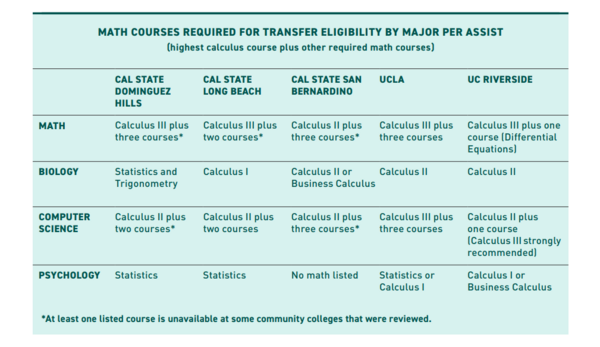You have /5 articles left.
Sign up for a free account or log in.

Math requirements can limit students’ ability to transfer into STEM programs, according to new research.
Fat Camera/E+/Getty Images
Prior research shows that a majority of community college students hope to earn a bachelor’s degree, but among those who transfer, only a fraction complete a four-year degree within six years. One of the factors that can prevent a student from successfully making the jump from a two-year to four-year institution is math credit requirements.
A May report from Just Equations analyzed California college students and transfer pathway success, with a focus on those looking to enter STEM fields or other calculus-required majors. Researchers identified three key obstacles that hold students back: math anxiety, complicated transfer policies and course scheduling conflicts.
“It is one thing for coursework to be challenging,” the report authors wrote. “Academic challenge can ensure that students are proficient in their fields and prepared for future success. It is quite another for the process itself to be the obstacle course that so many students describe.”
Methodology
To compile the report, researchers from Just Equations reviewed existing literature on transfer practices and interviewed 19 higher education professionals and 15 students involved in the transfer process.
What’s the need: Unfulfilled math requirements can impede students’ ability to transfer, but understanding and meeting those standards can be difficult due to unclear or misaligned requirements, according to the report.
A push to eliminate remedial education in California has improved the number of students taking college-level courses, but it remains unclear how such measures have impacted transfer populations, if at all.
Calculus, in particular, has served as a gatekeeper, prompting students to exit STEM paths or making them less likely to transfer into STEM programs compared to other fields. Math barriers also disproportionately deter minoritized populations from completing STEM degrees.
More than half of first-generation students and Black students who aspire to a degree in science, technology, engineering, mathematics or medicine did not have a bachelor’s degree within six years of enrolling, according to recent data from the Common App. Just under half of Latino STEMM students also failed to graduate with a bachelor’s degree within six years.
The study: In interviews, researchers identified three consistent themes:
- Math anxiety. Students had internalized a negative view of their math skills, which created feelings of anxiety around completing prerequisite courses, or dissuaded them from taking math courses altogether.
- Complex transfer systems. Transfer policies and processes can be convoluted and vary widely by institution, leaving many community college students struggling to figure them out. Math transfer requirements in particular can differ by system; for instance, the University of California requires a C-plus in math, but the CSU system requires only a C-minus to fulfill requirements. Required courses also vary by major or submajor, which can further confuse students. And even if students are aware of the requirements, it’s not always easy for them to find the relevant information as they navigate various webpages and tools.

- Course scheduling conflicts. Internal processes at the community college can also impede students’ ability to transfer, if courses are not offered in a way that makes it easy for students to complete them, such as by always offering them on the same day and time or only during a particular term. Sometimes a student’s lack of transportation limits their ability to enroll in courses with a lab requirement as well. Once at the four-year college, students may be asked to complete additional premajor courses or are passed over in a transfer window, further extending their time to degree.
Policy considerations: Researchers noted that conflicts within the transfer policy landscape can perpetuate difficulties for students. Some examples include:
- Innovation versus standardization. Colleges may revamp their STEM course offerings to stay modern and best prepare students for their careers, but that can create articulation barriers, because the courses don’t translate across other institutions with a system or state.
- Institutional autonomy versus systemwide consistency. While the state of California established an associate degree for transfer program to provide students with more opportunities to complete a four-year degree, not every college in California accepts A.D.T.s, meaning students have to navigate college-specific requirements to attend or will need to complete additional credits to be considered part of the major.
- Efficient completion versus academic quality. State policymakers have urged institutions to adopt measures that improve student completion and degree attainment, but faculty worry this push will sacrifice student learning and academic quality, leaving students underprepared for careers in STEM.
Based on their findings, the report authors argue that California should adopt statewide goals for transfer participation and completion that address STEM students in particular. Additionally, institutions and lawmakers should improve transparency and consistency of math articulation, ensure students have access to accurate and actionable information, and invest in student-centered instructional strategies.
Get more content like this directly to your inbox. Subscribe here.




